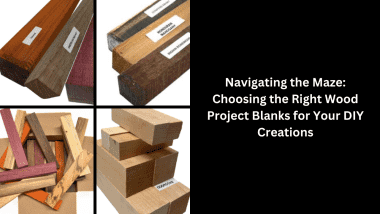Navigating the Maze: Choosing the Right Wood Project Blanks for Your DIY Creations ( lemmy.world )
Introduction:
Starting a do-it-yourself (DIY) woodworking project is an exciting adventure full of imagination and workmanship. However, one of the most important selections is choosing the right wood project blanks. The sort of wood you use has an impact not only on the appearance of your finished product but also on its longevity and utility. In this detailed guide, we'll walk you through the maze of alternatives, allowing you to make informed choices when choosing wood project blanks for your next DIY masterpiece.
Understanding wood characteristics:
Wood is as versatile as the projects it may inspire. Hardwoods such as oak, maple, and walnut give durability and a rich look, but softwoods such as pine and cedar are affordable and easy to work with. Consider the grain pattern, color variety, hardness, and workability of several wood species to ensure they meet the needs of your project.
Assessing Project Needs
Before plunging into a sea of possibilities, consider the individual needs of your project. Are you making furniture, kitchenware, or decorative items? When deciding on the ideal wood project blanks for your needs, keep size, intended usage, desired finish, and environmental conditions in mind.
Quality Counts:
When choosing wood, quality comes first. Inspect possible blanks for grain uniformity, moisture content, and lack of faults such as knots, cracks, and warping. Investing in high-quality wood blanks guarantees a smoother woodworking experience and a more pleasing final product.
Sustainability and ethical sourcing:
In an age of growing environmental consciousness, think about the sustainability of your wood selections. Look for suppliers who follow ethical forestry methods and provide certified wood products, such as those from the Forest Stewardship Council (FSC). Choosing sustainably sourced wood not only reduces your environmental impact but also promotes ethical and responsible forestry.
Investigating alternative options:
While classic wood species are popular, don't neglect other materials with distinct qualities and benefits. Engineered wood products, recycled wood, and hybrid materials may all give you unique textures and finishes for your DIY projects. By combining atypical materials with classic wood project blanks, you may expand your imagination and explore new possibilities.
Conclusion:
Choosing the appropriate wood project blanks is an important stage in the DIY woodworking process. Understanding wood properties, analyzing project demands, prioritizing quality and sustainability, and investigating alternative possibilities will allow you to confidently choose the ideal blanks for your work. Whether you're an experienced woodworker or just getting started, this book will help you navigate the maze of wood alternatives and convert your DIY aspirations into concrete works of art.
